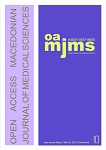The Relationship between the Type of Cleft and Nasal Air Emission in Speech of Children with Cleft Palate or Cleft Lip and Palate
DOI:
https://doi.org/10.3889/oamjms.2019.145Keywords:
Cleft palate, Cleft lip and palate, See-scape, Veau classification, Speech, Nasal air emissionAbstract
BACKGROUND: Cleft palate, due to damage of the soft palate, leads to dysfunction, i.e., inappropriate closure of the velopharynx during speech production, thus resulting in velopharyngeal insufficiency which characterises with hypernasal speech and nasal air loss/emission during speech production.
AIM: To establish the relationship between the type of cleft according to the Veau classification and the degree of nasal air emission in the speech of patients with cleft using auditory-visual perceptual assessment procedures.
MATERIAL AND METHODS: A group of 40 patients with irregular speech aged 4 to 7, out of which 20 with cleft palate or cleft lip and palate, participated in the research. The Veau classification was used to classify the cleft severity, while an indirect instrumental examination was conducted with the See-Scape instrument to detect nasal air emission during the speech.
RESULTS: The respondents with cleft palate or cleft lip and palate of higher Veau class had a greater degree of nasal air emission during the speech. There is a positive, statistically significant correlation between the results obtained with the Veau classification of cleft lip and palate, and the degree of nasal air emission. The value of Spearman’s coefficient of correlation is R = 0.46, and the calculated p-value is p = 0.04.
CONCLUSION: A more severe cleft type is associated with an increased degree of nasal air emission during the speech, and vice versa.
Downloads
Metrics
Plum Analytics Artifact Widget Block
References
American Cleft Palate-Craniofacial Association. Parameters for evaluation and treatment of patients with cleft lip/palate or other craniofacial anomalies. Revised Edition. Chapel Hill: American Cleft Palate-Craniofacial Association, 2004.
Leow AM, Lo LJ. Palatoplasty: evolution and controversies. Chang Gung Med J. 2008; 31(4):335-45. PMid:18935791
Johns DF, Rohrich RJ, Awada M. Velopharyngeal incompetence: a guide for clinical evaluation. Plast Reconstr Surg. 2003; 112(7):1890-7. https://doi.org/10.1097/01.PRS.0000091245.32905.D5 PMid:14663236 DOI: https://doi.org/10.1097/01.PRS.0000091245.32905.D5
Lam DJ, Chiu LL, Sie KCY, Perkins JA. Impact of Cleft Width in Clefts of Secondary Palate on the Risk of Velopharyngeal Insufficiency. Arch Facial Plast Surg. 2012; 14(5):360–364. https://doi.org/10.1001/archfacial.2012.169 PMid:22508897 DOI: https://doi.org/10.1001/archfaci.2012.169
Aras I. Govor djeteta nakon operacije nepca. U: Zorić A, Knežević P, Aras I. Rascjepi usne i nepca – multidisciplinarni pristup. Zagreb: Medicinska naklada, 2014:45-53.
Willging JP. Velopharyngeal insufficiency. Int J Pediatr Otorhinolaryngol. 1999; 49: S307–S309. https://doi.org/10.1016/S0165-5876(99)00182-2 DOI: https://doi.org/10.1016/S0165-5876(99)00182-2
He L, Zhang J, Liu Q, Yin H, Lech M, Huang Y. Automatic evaluation of hypernasality based on a cleft palate speech database. J Med Syst. 2015; 39(5):61. https://doi.org/10.1007/s10916-015-0242-2 PMid:25814462 DOI: https://doi.org/10.1007/s10916-015-0242-2
Kosowski TR, Weathers WM, Wolfswinkel EM, Ridgway EB. Cleft palate. Semin Plast Surg. 2012; 26(4):164-9. https://doi.org/10.1055/s-0033-1333883 PMid:24179449 PMCid:PMC3706041 DOI: https://doi.org/10.1055/s-0033-1333883
Kummer AW. Cleft Palate and Craniofacial Anomalies: The Effects on Speech and Resonance, 3rd Edition. Clifton Park: Cengage Learning, 2014:191.
Kummer AW. Speech and Resonance Disorders Related to Cleft Palate and Velopharyngeal Dysfunction: A Guide to Evaluation and Treatment. Perspectives on School-Based Issues. 2014; 15(2):57. https://doi.org/10.1044/sbi15.2.57 DOI: https://doi.org/10.1044/sbi15.2.57
Bluestone CD. Cleft Palate Classification. Pediatric Otolaryngology, 5th Edition. PMPH-USA, 2013:1166.
Ahmed MK, Maganzini AL, Marantz PR, Rousso JJ. Risk of Persistent Palatal Fistula in Patients with Cleft Palate. JAMA Facial Plast Surg. 2015; 17(2):126-130. https://doi.org/10.1001/jamafacial.2014.1436 PMid:25611055 DOI: https://doi.org/10.1001/jamafacial.2014.1436
Blaži D, Turkalj M, Dembitz A. Ballovent set u dijagnostici i terapiji nazalnosti i hipernazalnosti kod djece s orofacijalnim rascjepima. Logopedija. 2010; 2(1):27-35.
See-Scape visual feedback of nasal emission. Pro-Ed, Inc., 1986.
De Bodt M, Van Lierde K. Cleft palate speech and velopharyngeal dysfunction: the approach of the speech therapist. B-ENT. 2006; 2(Suppl 4):63-70. PMid:17366850
Kaewkumsan et al. Clinical Outcomes of Primary Palatoplasty in Preschool-Aged Cleft Palate Children in Srinagarind Hospital and Comparison with Other Standard Cleft Centers. J Med Assoc Thai 2014; 97(Suppl 10):S37-S48. PMid:25816536
Garcia-Vaquero et al. Otologic, audiometric and speech findings in patients undergoing surgery for cleft palate. BMC Pediatrics. 2018; 18:350. https://doi.org/10.1186/s12887-018-1312-7 PMid:30409226 PMCid:PMC6225714 DOI: https://doi.org/10.1186/s12887-018-1312-7
Dotevall H, Lohmander-Agerskov A, Ejnell H, Bake B. Perceptual evaluation of speech and velopharyngeal function in children with and without cleft palate and the relationship to nasal airflow patterns. The Cleft palate-craniofacial journal. 2002; 39(4):409-24. https://doi.org/10.1597/1545-1569_2002_039_0409_peosav_2.0.co_2 PMid:12071789 DOI: https://doi.org/10.1597/1545-1569_2002_039_0409_peosav_2.0.co_2
Marrinan EM, LaBrie RA, Mulliken JB. Velopharyngeal function in nonsyndromic cleft palate: relevance of surgical technique, age at repair, and cleft type. The Cleft Palate-Craniofacial Journal. 1998; 35(2):95–100. https://doi.org/10.1597/1545-1569_1998_035_0095_vfincp_2.3.co_2 PMid:9527305 DOI: https://doi.org/10.1597/1545-1569_1998_035_0095_vfincp_2.3.co_2
Timmons MJ, Wyatt RA, Murphy T. Speech after repair of isolated cleft palate and cleft lip and palate. Br J Plast Surg. 2001; 54(5):377-84. https://doi.org/10.1054/bjps.2000.3599 PMid:11428766 DOI: https://doi.org/10.1054/bjps.2000.3599
Coston GN, Hagerty RF, Jannarone RJ, McDonald V, Hagerty RC. Levator muscle reconstruction: resulting velopharyngeal competence—a preliminary report. Plast Reconstr Surg. 1986; 77(6):911–916. https://doi.org/10.1097/00006534-198606000-00006 PMid:3714888 DOI: https://doi.org/10.1097/00006534-198606000-00006
Yuan N, Dorafshar AH, Follmar KE, Pendleton C, Ferguson K, Redett RJ 3rd. Effects of cleft width and veau type on incidence of palatal fistula and velopharyngeal insufficiency after cleft palate repair. Ann Plast Surg. 2016; 76(4):406-410. https://doi.org/10.1097/SAP.0000000000000407 PMid:26101973 DOI: https://doi.org/10.1097/SAP.0000000000000407
Downloads
Published
How to Cite
Issue
Section
License
Copyright (c) 2019 Tatjana Georgievska-Jancheska

This work is licensed under a Creative Commons Attribution-NonCommercial 4.0 International License.
http://creativecommons.org/licenses/by-nc/4.0







